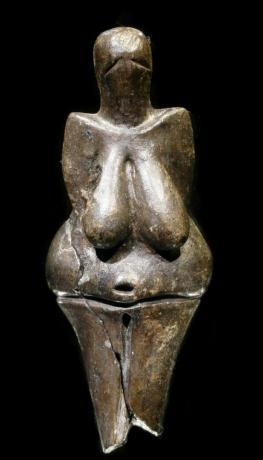Paleolithic Art: its origins and characteristics
Probably, if we think of prehistoric art or Paleolithic art, the first thing that will come to mind is the so-called rock painting. But, although it is true that it is one of the most surprising and well-known artistic manifestations of this period, it is not the most abundant, much less the only one.
Join us on this tour of Paleolithic art, the first artistic manifestations of humanity.
- Related article: "Is there an art objectively better than another?"
What are the origins of Paleolithic art?
In recent years, the theory that the Homo sapiens he was not the first human being to create art. In light of the most recent scholarship, this honor falls to his closest cousin, Neanderthal Man, who lived during the Middle Paleolithic (200,000-35,000 BC). c.).
These first Neanderthal artistic manifestations have been found in three Spanish caves: La Pasiega, in Cantabria, Maltavieso, in Extremadura, and Los Ardales, located in Andalusia.

In all three, artificial pigments were found on the walls, whose scientific dating was around 64,000 BC. C., that is, at the time when Neanderthals populated Europe.
The controversy was served. Were these pigments really intentional, or were they just the result of a deterioration of the minerals in the cave? Be that as it may, everything seems to point to the fact that the Neanderthals possessed an obvious symbolic capacity, embodied in religious and burial rituals, which seems to lend weight to the theory that they also had creativity artistic. On the other hand, the body decorations that have been found, made with shells and bones of animals, corroborate the hypothesis that, indeed, the Neanderthal was capable of expressing artistically.
- You may be interested in: "The 5 ages of History (and their characteristics)"
The great explosion of art: the Upper Paleolithic
What does not cast any kind of doubt is the existence of art during the last period of the Paleolithic, known as the Upper Paleolithic (a. 35,000 – 9,000 BCE c.). In this period, modern man, the Homo sapiens, has already spread, coming from Africa, throughout the globe, so artistic manifestations can be found in many parts of the planet. However, Europe is where more Paleolithic artistic remains have remained.
In relation to rock art or parietal art, the geographical concretion is much more specific: the regions of the present-day France and the Cantabrian coast, with some other manifestations on the Mediterranean coast and the Meseta central. Why is cave art so restricted? What happened to the other European regions, where the Homo sapiens? Why is rock art concentrated in the aforementioned areas?
A probable explanation is the survival of the glaciation in the north of the continent, from which only the Mediterranean coastal strip was spared. In these regions, the climate was beginning to be quite temperate, auguring the new period that would come with the Neolithic. However, this reason does not explain why numerous examples of movable art have been preserved in areas far from the temperate zone, such as the Danube, the Don and Lake Baikal.
In fact, mobile art is much more abundant than rock art, and we find testimonies all over Europe: female statues traditionally linked to the cult of fertility, tools with decorations and engravings, body ornaments... Much has been said about the supposed meaning of these objects: did they have a ritual purpose, or merely aesthetic? We will talk about this at another point.
- Related article: "The psychology of creativity and creative thinking"
Rock art or parietal art
Rupestre comes from the Latin word rupees, which means “rock”. It was the first name given to the art embodied on the walls of the caves, although it is currently also known as parietal art, of “wall”. One thing that we must keep in mind is that the term rock art is not limited only to prehistoric art, as wall decoration survived long after the end of the Paleolithic. On the other hand, and as we have already pointed out in the previous section, we should not think that all the manifestations The artistic works of this period are cave paintings, since we have already seen how movable art also existed, that is, art transportable.
The dr. María Isabel Rodríguez López has a magnificent essay on the art of the Upper Paleolithic. Following the studies of Professor Ripoll, Dr. Rodríguez exposes the five artistic techniques that human beings of the period followed:
- The first of these is the one known by the curious name of macaroni: digital marks made on clay surfaces.
- The second, the engravings on hard material, made with flint tools.
- A third technique that consists of reliefs.
- The fourth, the round sculpture, whose maximum exponent are the Paleolithic Venus.

- And, finally, a fifth technique, which is the one that concerns us in this section, which is none other than the polychrome, red, black or ocher paint from caves, but which can also be found on bones of animals.
The great manifestations of parietal or rock art are those of Lascaux, in the French Dordogne, and those of Altamira, in Cantabria, Spain.. The first ones were discovered in 1940 by some teenagers looking for their lost dog, and they soon gained enormous popularity due to the astonishing naturalism of their execution.
More than 2,000 20,000-year-old representations were found in the Lascaux caves. The most abundant figures are those of animals, especially horses, mammoths, deer and bison, which constitute the most evident leitmotif of Paleolithic rock art. We find similar representations, although aesthetically very different, in Altamira, Spain, where, in the 17th century In the 19th century, some caves were also discovered by chance, whose Great Room or Central Room houses an artistic treasure matchless.
Human representations are later. The first are usually of a feminine nature, especially representations of vulvas, an unequivocal symbol of fertility. Quite abundant are also hybrid characters, that is, men with animal attributes, often identified with tribal totems or with shamanic figures executing a ritual.
In any case, the vast majority of Paleolithic cave painting is meaningless. narrative, although with notable exceptions, such as the famous man attacked by a deer from the cave of Lascaux. The most usual, however, is that the representations are juxtaposed and do not relate to each other.
What function did these prehistoric artistic representations have?
Apart from the testimonies of the caves, which are really scarce, the artistic manifestations of the Paleolithic that are most abundant are those of mobile art, that is, transportable. Especially famous are the Venus, small figurines made with various materials that represent female figures with exaggerated sexual attributes, which have been associated with a cult of fertility and the Great Goddess.
The actual meaning of these representations, however, remains unclear. Not only the one of the Venus, but also that of the cave paintings (especially the enigmatic signs and shapes abstract shapes that often accompany animals), as well as the ornaments of the tools used daily. Did they originate from a ritual? So were they of a religious nature?
In the cited work of Dr. Rodríguez López some hypotheses considered by the scholars of the Prehistory, which, by the way, is a relatively recent discipline. g. h. Luquet proposed the theory of artistic creation as a spontaneous impulse of adornment, that is, merely aesthetic. For his part, in 1906, W. Worringer launched the idea of "cosmic anxiety" as the origin of art; in other words, the fruit of a spiritual need.
In 1903, Salomon Reinach published his work L'art et la magie, where he relates the art of the Paleolithic with magic. According to this theory, the animals depicted on the surfaces of the caves would be nothing more than invocations of what the prehistoric human being wanted: a good hunt. In the same way, elements such as vulvas or female statuettes with exaggerated sexual organs would have a connection with the group's desire for fertility and the perpetuation of the tribe.
Unfortunately, the men and women who created Paleolithic art left nothing written. to give us a clue about his intentions, since the deed would still be a long time coming. We must, therefore, resign ourselves to the mystery. Perhaps this, rather than a problem, is one of the great attractions of the artistic manifestations of the prehistoric human being.



